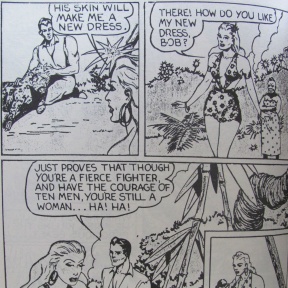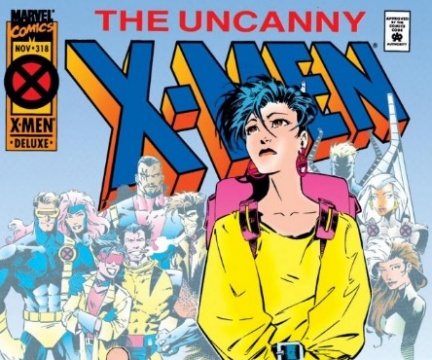The first Monday of every month, this column looks back at three historical events from the comic industry that are connected to that month. For September 2019, we examine “Jumbo Comics”, the first 3D comic, and deluxe versions of the X-Men.

September 1938
In the 1920s, T.T. Scott’s Fiction House had been a leading publisher of pulp magazines, but the Great Depression hit it hard and by the late 1930s it was a small operation. The Eisner-Iger packaging studio convinced Scott to enter the booming field of comic books. They sold him material they had previously sold to an English tabloid newspaper, “WAGS”. Fiction House retained the original publication size (10.5″x14.5″) and released the 68-page first issue of “Jumbo Comics” in September 1983. It starred a swashbuckling adventure hero called the Hawk and included several back up stories, all in black and white.
This was a period of intense innovation in comics, and “Jumbo” was lost among other noteworthy debuts. Any other publisher probably would have canceled it, but Fiction House was committed to rebuilding its reputation. The page count was reduced to 52 beginning with issue four, then jumped back to 68 with the ninth issue, which also reduced the book’s dimensions to the contemporary standard. The size change allowed newsstand retailers to display it with other comics, and the introduction of color artwork made it more appealing. The ninth issue also debuted a new lead feature that combined science fiction adventure with the supernatural.
The real saving grace for “Jumbo” came in issue ten. Since issue one, the comic had included backup stories about Sheena, a white girl orphaned in the African jungle and cared for by natives who taught her their ways in addition to Western values. In her first nine appearances, Sheena was a typical damsel in distress wearing a typical dress. In her tenth appearance, she made a revolutionary jump to become a ferocious fighter and Fiction House’s new star attraction. In the scene above (from issue ten), she gets her iconic leopard skin outfit and becomes Queen of the Jungle.
Thereafter, Sheena was the standard cover feature for “Jumbo”. Her self-titled spin-off debuted in the Spring of 1942 and was the first comic named after a female character. She had a great run and inspired many imitators, but they came under attack during the anti-comics movement in the early 1950s for their rampant sexual imagery. While many of the criticisms leveled by the moral crusaders were unfounded or lacked context, this particular element may have been valid. At least one artist, Bob Webb, drew Sheena naked in every panel and let his background artist or inker cover up the inappropriate details.
Although it outlasted many of its jungle-themed competitors, “Jumbo” ended after 167 issues in March 1953. Modern audiences might find the concern about the sexual imagery quaint, but years of cultural development have given rise to a new criticism of the work. Sheena and her kin are now held up as enablers of Western colonialism, propagating the idea that other societies needed the protection of white heroes.

September 1953
In the early 1950s, a new craze had hit American audiences: 3D movies. Two comic artists, Joe Kubert and Norman Maurer developed a way to recreate the effect in comic books and proposed the idea of “ Three Dimensional Comics” to Archer St. John, proprietor of St John Publishing. The gimmick seemed like a good way to stand out from the other 500 comic titles being published each month, and he decided to test it on his most successful character, Mighty Mouse.
To work properly, “Mighty Mouse 3D” required red and green glasses. The process also raised production costs, forcing St John to charge a quarter for it in an era where every other comic on the stands was a dime. The initial print run was 1.25 million and upon its release in September 1953, it was an instant and unqualified success with 99% sell-through on newsstands. A second printing was rushed and released in October.
Thrilled with this development, St John immediately expanded 3D to his whole line. He hired 30 new artists and increased his print runs significantly. He had 5 new 3D titles in October and 7 in November. Rumors about his results spread and in December there were 30 unique 3D books from 16 publishers. Only after this rapid investment was the “success” revealed for what it really was.
Continued belowKids had been suckered by the gimmick, buying the one enhanced comic instead of two others and some candy. When they tried to actually read the thing, they discovered the poor color separation on newsprint prevented the effect from working the way it had on Kubert and Maurer’s original artwork. Either no one at St John tested the printed product, or they thought kids wouldn’t care. The kids did care, and sell-through on the second wave of 3D comics dropped to 35% and kept falling into the 10% range as the months went by.
Publishers pulled out of the fad even quicker than they’d jumped into it. From 30 3D comics in December 1953, there were zero in February 1954. St John suffered the hardest and was near collapse. Sales of his regular Mighty Mouse comics kept him afloat for a while, but his losses on investment (plus other cultural impacts on comics at the time) saw him shutter his doors by 1956.
Publishers have occasionally tried to revive the 3D format in the decades since. In September 1994, Harvey Comics issued a “Double Vision” adaptation of the Flintstones live action movie with 3D glasses. Oddly, it wasn’t actually a 3D comic. Instead of the red and blue lines working together to create an illusion, the red lines were drawn by Howard Bender to look like the film, and the blue lines were drawn by Rusty Haller in the traditional cartoon style. Same story, same basic layout, wildly different artwork. It was effectively two comic books, but you could only read it with one eye open and I found (trying to) read it was a very uncomfortable experience. In November 2008, IDW reissued its “Transformers Spotlight: Optimus Prime” issue in 3D in a more traditional manner with color separations that allowed it to work the way it should. In February 2019, Madefire announced 3D motion comics that overlay comic images on the viewer’s field of vision using augmented reality glasses.

September 6, 1994
The early 1990s were a time of great upheaval in the comics world. The formation of Image Comics accelerated the adoption of higher quality paper and color separations. The increasing use of computers in artwork meant linework and color gradients were getting lost as the ink bled on newsprint. Meanwhile, wholesale paper prices were spiking and putting pressure on publishers of all kinds to raise prices. Plus, Marvel was struggling to raise its stock price during an industry downturn.
All these factors combined to produce the deluxe edition of “Uncanny X-Men” #318, released September 6, 1994. Previously available only on newsprint for $1.50, the deluxe edition offered glossy paper (and all the printing advantages that provides) for $1.95. As the name implies, there was still a standard newsprint edition available for $1.50. Readers got a choice, collectors got a second variant to buy, and Marvel could theoretically see which format readers really preferred. This experiment extended across the whole line, meaning that titles like “Wolverine” and “Cable”, which were previously only available in the glossy $1.95 format would now also be available in the cheaper format. Everyone wins!
Except there was one other difference between standard and deluxe: release date. The higher priced deluxe version went on sale a full two weeks before the newsstand version. The extra $0.45 didn’t just get you nicer paper, it gave you an edge. Since few fans read comics in a vacuum and no one wanted to be the last to find out how Professor X was going to die, many felt they didn’t really get a choice in what they were paying. Plus, according to “Wizard” magazine, the deluxe editions could double in value while the standard editions were still selling for cover price.
The trial didn’t last long – just four months later the franchise fell into the ‘Age of Apocalypse’ crossover. Halfway through the event, the “standard” editions were gone. The comics lost the “deluxe” description, but retained the price and format.






